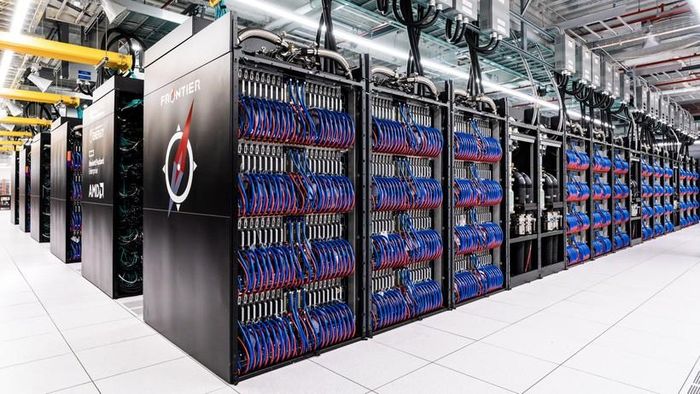The 7 most powerful supercomputers today

Currently, supercomputers are considered to have the fastest data processing speed on the planet.
Supercomputers operate on the same principles as regular computers, but their performance levels are much higher and they look similar to ancient computers.
Unlike desktop or laptop computers, supercomputers process huge data sets and perform calculations at incredible speeds. They are the fastest computers in the world, requiring massive infrastructure to operate, including advanced cooling systems.
In terms of structure, supercomputers include more components than desktop computers. Laptops may have one central processing unit (CPU) and one graphics processing unit (GPU), but supercomputers have thousands of CPUs and GPUs. Their performance is measured in floating point operations per second (FLOPS).
The most powerful supercomputer in the world today has a capacity of one exaFLOP, equal to one million billion FLOPS. Such machines are often called exascale supercomputers.
Because supercomputers can work with huge amounts of data and process calculations extremely quickly, scientists often use them in discovering new drugs and materials.
Supercomputers can also make predictions such as weather forecasting, playing chess. Below are the 7 most powerful supercomputers in the world in operation, as voted by the global ranking site TOP500.
Frontier
Frontier is located at Oak Ridge National Laboratory (Tennessee, USA). With a performance of 1,194 petaFLOPS (equivalent to 1.2 extraFLOPS), the supercomputer includes a 64-core AMD EPYC CPU and AMD Instinct MI250X GPU.
Topping the list of the world's fastest supercomputers, Frontier was built by supercomputer company PHE Cray and became the world's first exascale computer. Frontier first operated in August 2022. Initially, scientists planned to use Frontier to research cancer, discover drugs, fusion reactions, new materials, design super-efficient engines, model stellar explosions.
In the coming years, scientists will use Frontier to design new transportation and medical technology. Mr. Evan Schneider - Assistant Professor of computational astrophysics at the University of Pittsburgh revealed that he wants to run a simulation of the Milky Way's evolution over time thanks to Frontier.
Aurora
Located at Argonne National Laboratory (ALCF) (Illinois, USA), with a capacity of 585 petaFLOPS (equivalent to 0.59 exaFLOPS), this supercomputer first operated in June 2023.
Aurora - the second exascale supercomputer built, is one of the youngest supercomputers on the list but has the potential to be the most powerful in the future. ALCF representatives said that Aurora has the potential to reach 2 exaFLOPS of computing power, double that of Frontier.
Supercomputers integrate scientific tools and analysis, perform modeling, simulation, and run artificial intelligence (AI). Aurora's power allows it to create accurate models in many areas, including climate prediction, materials science, energy storage and fusion reactions. Fusion reactions, in particular, are central to Aurora.
Eagle
Microsoft Azure is the 'father' of the Eagle supercomputer with a performance of 561 petaFLOPS (equivalent to 0.56 exaFLOPS). First operating in August 2023, the Eagle supercomputer is not located in a laboratory.
Eagle is based on cloud technology so anyone can access it through the Microsoft Azure cloud platform. This is a distributed network of systems with enough collective capacity to be the third fastest supercomputer in the world.
Fugaku
The Fugaku supercomputer is located at the Riken Computer Science Center (Kobe, Japan) with a performance of 442 petaFLOPS (equivalent to 0.44 exaFLOPS). Once the world's most powerful supercomputer from June 2020 to June 2022, Fugaku is one of the longest-running supercomputers. Its name comes from Mount Fuji, an active volcano located about 100 km from Tokyo.
Scientists use Fugaku for a number of key research problems. During the Covid-19 pandemic, researchers used its computing power to confirm that masks made of nonwoven fibers were more effective at blocking airborne droplets. Currently, Fugaku is training a language model similar to ChatGPT.
Lumi
CSC Data Center (Kajaani, Finland) owns the Lumi supercomputer, with a capacity of 280 petaFLOPS (equivalent to 0.38 exaFLOPS). Lumi, operational since June 2021, is the most powerful supercomputer in Europe and the 5th fastest in the world.
According to the European Union, Lumi uses 100% hydroelectricity and waste heat from the machine is used to warm nearby buildings. Lumi began testing 3 years ago and went into full operation in February 2023.
Lumi is designed to help scientists across Europe use and collaborate on research. This supercomputer is optimized for AI-based work. It is also a partner for quantum computers such as the QAL 9,000 and Helmi systems both in Finland.
Leonardo
The Leonardo supercomputer located at the CINECA Data Center (Bologna, Italy) has a capacity of 239 petaFLOPS (equivalent to 0.23 exaFLOPS). First operational in November 2022, Leonardo is another system in the EU's EuroHPC supercomputer program.
The Leonardo consists of three modules that combine to make it the second fastest machine in Europe. The organization that manages the machine, CINECA, is a coalition of Italian universities, research centers and government agencies. This supercomputer enters the pre-production phase in May 2023 and goes into production in August of the same year.
Summit
Summit is owned by Oak Ridge National Laboratory (Tennessee, USA) with a performance of 149 petaFLOPS (equivalent to 0.15 exaFLOPS). The supercomputer first operated in June 2018.
Developed for use at Oak Ridge National Laboratory, Summit is eight times more powerful than the institute's previous supercomputer, Titan. It was also the most powerful supercomputer in the world for 2 years before being replaced by Fugaku.
In addition to scientific modeling, Summit is also optimized for AI-related activities including machine learning and deep learning in many fields such as medicine and materials discovery. This supercomputer has been the backbone of many important studies over the years.
For example, it can screen millions of drugs during the Covid-19 epidemic to determine which drugs can prevent the virus from entering or replicating in human cells, and is also used to model disturbances. .
You should read it
- Compare Nvidia RTX 4070 Super, RTX 4070 Super Ti and RTX 4080 Super
- AMD and Cray will build the world's fastest supercomputer for the US government
- Don't miss the biggest super moon view in 2017 in the afternoon and tonight, Vietnam can see it
- How to play Super Mario Bros on computer with NoxPlayer
- How will play Super Mario at 380,000 frames per second?
- How to download Marvel Super War for iOS and Android
- How to transfer the Holy SIM package to Super Holy SIM
- 20 pictures of super beautiful splendor around the world on November 14
May be interested
- What is supercomputer used for?
 supercomputers are a type of computer that is far more powerful than personal computers at any time in history.
supercomputers are a type of computer that is far more powerful than personal computers at any time in history. - This is the most beautiful data center in the world, and it is placed in the church of God
 supercomputers marenostrum 4 is not the most powerful supercomputer in the world (the 25th strongest in the world) but it is the most beautiful supercomputer in the world and is placed in the church torre girona built in the 19th century, at bacsk university catalonia faculty in barcelona.
supercomputers marenostrum 4 is not the most powerful supercomputer in the world (the 25th strongest in the world) but it is the most beautiful supercomputer in the world and is placed in the church torre girona built in the 19th century, at bacsk university catalonia faculty in barcelona. - Successfully fabricated new conductive 2D materials at the speed of light
 new 2d materials that conduct electricity at the speed of light are the latest scientifically engineered products that can be applied to future supercomputers and quantum computers.
new 2d materials that conduct electricity at the speed of light are the latest scientifically engineered products that can be applied to future supercomputers and quantum computers. - Used since the 1990s, nearly 30-year-old 'supercomputers' are still running 'ferry ferries' and play an important role in many countries.
 it can be said that the development of supercomputers is a major 'arms race' in the 1990s, when the us, china and other countries were competing fiercely in creating a machine. fastest calculation.
it can be said that the development of supercomputers is a major 'arms race' in the 1990s, when the us, china and other countries were competing fiercely in creating a machine. fastest calculation. - The difference between quantum computers and supercomputers
 two particularly advanced inventions, supercomputers and quantum computers, have many applications and potential. but what is the difference between a supercomputer and a quantum computer, and which is better?
two particularly advanced inventions, supercomputers and quantum computers, have many applications and potential. but what is the difference between a supercomputer and a quantum computer, and which is better? - Toshiba's algorithm helps normal computers calculate faster than supercomputers
 normal computers will optimize the combination much faster than supercomputers.
normal computers will optimize the combination much faster than supercomputers. - Top 5 powerful PDF merging software and how to use it
 pdf merging tools are very popular today, but not all are perfect. in this article, dexterity software will introduce to you the top 5 extremely powerful pdf merging software and how to use it.
pdf merging tools are very popular today, but not all are perfect. in this article, dexterity software will introduce to you the top 5 extremely powerful pdf merging software and how to use it. - Benchmark the 4 most popular browsers today to see which one is faster and consumes less RAM
 neowin news site recently performed performance benchmarks with the 4 most popular browsers today (chrome, firefox, edge and vivaldi) to find out which web browser is the fastest, most powerful and most suitable for use on windows today.
neowin news site recently performed performance benchmarks with the 4 most popular browsers today (chrome, firefox, edge and vivaldi) to find out which web browser is the fastest, most powerful and most suitable for use on windows today. - Summary of the 10 most powerful computer chips today
 choosing a chip with strong configuration is an ideal choice for those who need to use advanced operations.
choosing a chip with strong configuration is an ideal choice for those who need to use advanced operations. - There were benchmark scores of Galaxy S10 / S10 +, the most powerful Android smartphone today, surpassing iPhone XS on graphics points
 after the galaxy s10 / s10 + and s10e generations are released, tom's guide page immediately made benchmark tests to verify the true power of this trio.
after the galaxy s10 / s10 + and s10e generations are released, tom's guide page immediately made benchmark tests to verify the true power of this trio.










 YouTube switched to the AV1 codec, which helps increase video quality without consuming a lot of data
YouTube switched to the AV1 codec, which helps increase video quality without consuming a lot of data How to find the source of an image on Google
How to find the source of an image on Google Instructions for creating chat folders on Telegram
Instructions for creating chat folders on Telegram Microsoft cites three reasons not to use the iPerf3 tool on Windows
Microsoft cites three reasons not to use the iPerf3 tool on Windows How to check battery level on Windows 10 laptop
How to check battery level on Windows 10 laptop